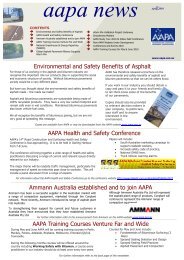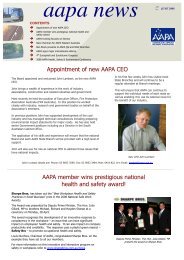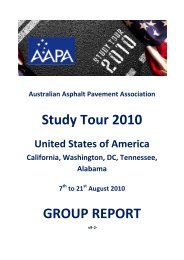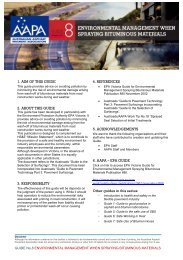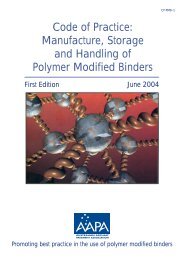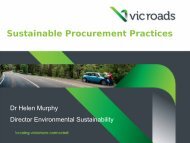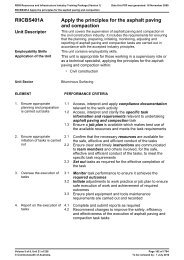Asphalt Review - Volume 29 Number 2 (June / July 2010)
Asphalt Review - Volume 29 Number 2 (June / July 2010)
Asphalt Review - Volume 29 Number 2 (June / July 2010)
Create successful ePaper yourself
Turn your PDF publications into a flip-book with our unique Google optimized e-Paper software.
ASPHALT REVIEW<br />
Smoothness Matters<br />
The US <strong>Asphalt</strong> Pavement Alliance has released a publication “Smoothness Matters”. This emphasises<br />
the importance of well maintained flexible pavements to save costs for the community and reduce<br />
emissions to the environment. It is therefore as relevant to Australia as it is to the US.<br />
The US <strong>Asphalt</strong> Pavement Alliance<br />
(ACA) publication “Smoothness Matters”<br />
comments that pavement smoothness<br />
is a significant determinant of vehicle<br />
fuel economy. That is, the smoother<br />
the pavement, the lower a vehicle’s<br />
fuel consumption. This is as pavement<br />
smoothness affects the rolling resistance<br />
by influencing friction between the tyre<br />
and the pavement.<br />
This makes common sense – the less<br />
rolling resistance, the less energy necessary<br />
to drive a vehicle along the pavement.<br />
However, how much difference can<br />
the pavement smoothness make to fuel<br />
consumption?<br />
Smoothness Matters refers to a full<br />
scale field study conducted – it was a fullscale<br />
field study conducted by the Federal<br />
Highway Administration at the WesTrack<br />
pavement test track in Nevada. This study<br />
indicated that trucks running on slightly<br />
smoother pavement could reduce fuel<br />
consumption by 4.5 percent. Other studies<br />
show similar or sometimes greater fuel<br />
savings with cars running on smoother<br />
pavements.<br />
Studies also show that the savings<br />
are even greater when one compares<br />
the roughest pavements in a highway<br />
network with the smoothest. Some experts<br />
estimate that it is possible to reduce fuel<br />
RoadsJobs consumption 15/6/10 by as 12:40 much PM as Page 10% 1 by<br />
rehabilitating the roughest pavements.<br />
Not only do smoother pavements reduce<br />
fuel consumption, they also reduce vehicle<br />
operating costs and driver fatigue by<br />
minimizing tyre bounce and load impacts.<br />
According to figures developed by the US<br />
Road Information Program (TRIP), driving<br />
on rough roads costs the US motorists $23<br />
billion annually in extra vehicle operating<br />
costs.<br />
Smoother pavements also last longer as<br />
truck tyres roll along the pavement instead<br />
of bouncing on each bump.<br />
Even small bumps, accelerate the rate of<br />
road deterioration. Studies in the US show<br />
that improving pavement smoothness by<br />
25% results in almost a 10% increase in<br />
pavement longevity. This saves taxpayers<br />
money and conserves natural resources.<br />
Keeping a road smooth begins with a<br />
well-engineered foundation and pavement<br />
structure. An asphalt “perpetual pavement”<br />
is designed and built to ensure that the<br />
structure lasts virtually indefinitely.<br />
Routine maintenance is simply a matter<br />
of infrequently milling the surface for<br />
recycling, followed by placing a smooth<br />
new asphalt overlay, a task that can be<br />
done quickly with short road or lane<br />
closures and little impact on traffic.<br />
It has been determined that if the roads<br />
across the US could be made slightly<br />
smoother there would be a saving of at<br />
least 4 percent of the fuel consumed.<br />
This would reduce annual vehicle fuel<br />
consumption by about 7 billion gallons,<br />
equivalent to taking over 10 million<br />
vehicles off the road every year, reducing<br />
fuel and vehicle maintenance<br />
While we don’t use as much fuel as<br />
the US, smoother roads in Australia<br />
would have a significant impact on<br />
fuel consumption. The use of asphalt<br />
pavements is the most effective means of<br />
achieving and maintaining smooth roads.<br />
<strong>Asphalt</strong> surfaces can also be made to<br />
meet a range of requirements such as low<br />
noise, skid resistance and to minimise<br />
water spray and can be readily maintained<br />
at low cost and minimal disruption.<br />
The ACA document can be downloaed<br />
in full from http://asphaltroads.org.<br />
For a full discussion of studies on<br />
this topic, Marks, Howard, PhD. 2009.<br />
Smoothness Matters: The Influence of<br />
Pavement on Fuel Consumption. Hot<br />
Mix <strong>Asphalt</strong> Technology Vol. 14, No. 6,<br />
pp. 18-<strong>29</strong>, available at www.nxtbook.<br />
com/nxtbooks/naylor/NAPS0609/index.<br />
php#/18.<br />
The US <strong>Asphalt</strong> Pavement Alliance is<br />
a joint venture between the US National<br />
<strong>Asphalt</strong> Pavement Association (NAPA), the<br />
US Bitumen Institute and US State <strong>Asphalt</strong><br />
Pavement Associations. APA has just<br />
released a new publication highlighting<br />
the benefits of asphalt pavement, lower<br />
fuel consumption.<br />
THE LEADING JOB WEBSITE FOR<br />
AUSTRALIA’S ROADS INDUSTRY<br />
34 ROADS JUNE <strong>2010</strong>/JULY <strong>2010</strong><br />
The #1 Google search for “road jobs”<br />
www.roadjobs.com.au<br />
www.roadjobs.com.au



